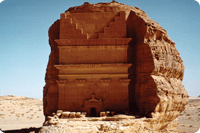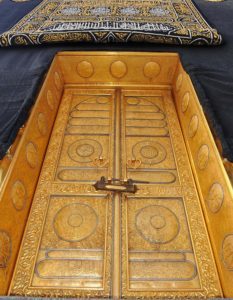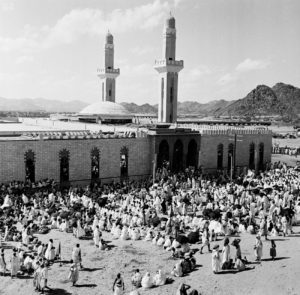Saudi Arabia traces its roots back to the earliest civilisations of the Arabian Peninsula. Over the centuries, the peninsula has played an important role in history as an ancient trade centre and as the birthplace of Islam, one of the world’s major monotheistic religions.
Since King Abdulaziz Al-Saud established the modern Kingdom of Saudi Arabia in 1932, its transformation has been astonishing.
In a few short decades, the Kingdom has turned itself from a desert nation to a sophisticated, modern state and a major player on the international stage.
Early History 
The first concrete evidence of human presence in the Arabian Peninsula dates back to between 15,000 and 20,000 years. Bands of hunter-gatherers roamed the land, living off wild animals and plants.
As the European ice cap melted during the last Ice Age, some 15,000 years ago, the climate in the peninsula became dry. Vast plains once covered with lush grasslands gave way to scrubland and deserts, and wild animals vanished. River systems also disappeared, leaving in their wake the dry river beds (wadis) that are found in the peninsula today.
 This climate change forced humans to move into the lush mountain valleys and oases. No longer able to survive as hunter-gatherers, they had to develop another means of survival. As a result, agriculture developed – first in Mesopotamia, then the Nile River Valley, and eventually spreading across the Middle East.
This climate change forced humans to move into the lush mountain valleys and oases. No longer able to survive as hunter-gatherers, they had to develop another means of survival. As a result, agriculture developed – first in Mesopotamia, then the Nile River Valley, and eventually spreading across the Middle East.
The development of agriculture brought other advances. Pottery allowed farmers to store food. Animals, including goats, cattle, sheep, horses and camels, were domesticated, and people abandoned hunting altogether. These advances made intensive farming possible. In turn, settlements became more permanent, leading to the foundations of what we call civilisation – language, writing, political systems, art and architecture.
An Ancient Trade Centre
Located between the two great centres of civilization, the Nile River Valley and Mesopotamia, the Arabian Peninsula was the crossroads of the ancient world. Trade was crucial to the area’s development; caravan routes became trade arteries that made life possible in the sparsely populated peninsula.
The people of the peninsula developed a complex network of trade routes to transport agricultural goods highly sought after in Mesopotamia, the Nile Valley and the Mediterranean Basin. These items included almonds from Taif, dates from the many oases, and aromatics such as frankincense and myrrh from the Tihama plain.
Spices were also important trade items. They were shipped across the Arabian Sea from India and then transported by caravan.
The huge caravans travelled from what is now Oman and Yemen, along the great trade routes running through Saudi Arabia’s Asir Province and then through Makkah and Madinah, eventually arriving at the urban centres of the north and west.
The people of the Arabian Peninsula remained largely untouched by the political turmoil in Mesopotamia, the Nile Valley and the eastern Mediterranean. Their goods and services were in great demand regardless of which power was dominant at the moment – Babylon, Egypt, Persia, Greece or Rome. In addition, the peninsula’s great expanse of desert formed a natural barrier that protected it from invasion by powerful neighbours.
The Birth of Islam 
 Around the year 610, Muhammad, a native of the thriving commercial centre of Makkah, received a message from God (in Arabic, Allah) through the Angel Gabriel. As more revelations bid him to proclaim the oneness of God universally, the Prophet Muhammad’s following grew.
Around the year 610, Muhammad, a native of the thriving commercial centre of Makkah, received a message from God (in Arabic, Allah) through the Angel Gabriel. As more revelations bid him to proclaim the oneness of God universally, the Prophet Muhammad’s following grew.
In 622, learning of an assassination plot against him, the Prophet led his followers to the town of Yathrib, which was later named Madinat Al-Nabi (City of the Prophet) and now known simply as Madinah. This was the Hijrah, or migration, which marks the beginning of the Islamic calendar.
Within the next few years, several battles took place between the followers of the Prophet Muhammad and the pagans of Makkah. By 628, when Madinah was entirely in the hands of the Muslims, the Prophet had unified the tribes so successfully that he and his followers re-entered Makkah without bloodshed.
The Islamic Empire 
Less than 100 years after the birth of Islam, the Islamic Empire extended from Spain to parts of India and China. Although the political centres of power had moved out of the Arabian Peninsula, trade flourished in the area.

A large number of pilgrims began regularly visiting the peninsula, with some settling in the two holy cities of Makkah and Madinah. These pilgrims facilitated the exchange of ideas and cultures between the people of the peninsula and other civilizations of the Arab and Muslim worlds.
The emergence of Arabic as the language of international learning was another major factor in the cultural development of the Arabian Peninsula. The Muslim world became a centre for learning and scientific advances during what is known as the “Golden Age.” Muslim scholars made major contributions in many fields, including medicine, biology, philosophy, astronomy, arts and literature. Many of the ideas and methods pioneered by Muslim scholars became the foundation of modern sciences.
The Islamic Empire thrived well into the 17th century, at which point it broke up into smaller Muslim kingdoms. The Arabian Peninsula gradually entered a period of relative isolation, although Makkah and Madinah remained the spiritual heart of the Islamic world and continued to attract pilgrims from many countries.
The First Saudi State
In the early 18th century, a Muslim scholar and reformer named Shaikh Muhammad bin Abdul Wahhab began advocating a return to the original form of Islam. Abdul Wahhab was initially persecuted by local religious scholars and leaders who viewed his teachings as a threat to their power bases. He sought protection in the town of Diriyah, which was ruled by Muhammad bin Saud.
Muhammad bin Abdul Wahhab and Muhammad bin Saud formed an agreement to dedicate themselves to restoring the pure teachings of Islam to the Muslim community. In that spirit, bin Saud established the First Saudi State, which prospered under the spiritual guidance of bin Abdul Wahhab, known simply as the Shaikh.
By 1788, the Saudi State ruled over the entire central plateau known as the Najd. By the early 19th century, its rule extended to most of the Arabian Peninsula, including Makkah and Madinah.
The popularity and success of the Al-Saud rulers aroused the suspicion of the Ottoman Empire, the dominant power in the Middle East and North Africa at the time. In 1818, the Ottomans dispatched a large expeditionary force armed with modern artillery to the western region of Arabia. The Ottoman army besieged Diriyah, which by now had grown into one of the largest cities in the peninsula. Ottoman forces levelled the city with field guns and made it permanently uninhabitable by ruining the wells and uprooting date palms.
The Second Saudi State
By 1824, the Al-Saud family had regained political control of central Arabia. The Saudi ruler Turki bin Abdullah Al-Saud transferred his capital to Riyadh, some 20 miles south of Diriyah, and established the Second Saudi State. During his 11-year rule, Turki succeeded in retaking most of the lands lost to the Ottomans. As he expanded his rule, he took steps to ensure that his people enjoyed rights, and he saw to their well-being.
Under Turki and his son, Faisal, the Second Saudi State enjoyed a period of peace and prosperity, and trade and agriculture flourished. The calm was shattered in 1865 by a renewed Ottoman campaign to extend its Middle Eastern empire into the Arabian Peninsula. Ottoman armies captured parts of the Saudi State, which was ruled at the time by Faisal’s son, Abdulrahman. With the support of the Ottomans, the Al-Rashid family of Hail made a concerted effort to overthrow the Saudi State.
Faced with a much larger and better equipped army, Abdulrahman bin Faisal Al-Saud was forced to abandon his struggle in 1891. He sought refuge with the Bedouin tribes in the vast sand desert of eastern Arabia known as the Rub’ Al-Khali, or ‘Empty Quarter.’ From there, Abdulrahman and his family traveled to Kuwait, where they stayed until 1902. With him was his young son Abdulaziz, who was already making his mark as a natural leader and a fierce warrior for the cause of Islam.
The Modern Kingdom of Saudi Arabia
The young Abdulaziz was determined to regain his patrimony from the Al-Rashid family, which had taken over Riyadh and established a governor and garrison there. In 1902, Abdulaziz, – accompanied by only 40 followers – staged a daring night march into Riyadh to retake the city garrison, known as the Masmak Fortress. This legendary event marks the beginning of the formation of the modern Saudi state.
After establishing Riyadh as his headquarters, Abdulaziz captured all of the Hijaz, including Makkah and Madinah, between 1924 and 1925. In the process, he united warring tribes into one nation.
On 23 September, 1932, the country was named the Kingdom of Saudi Arabia, an Islamic state with Arabic as its national language and the Holy Qur’an as its constitution.
